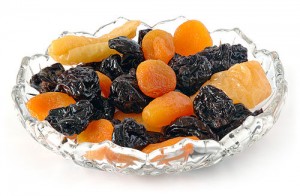Why Dry?
Dehydration is one of several ways to store food. The process involves removing most of the water from food by using heat. Heat, regardless of the source, kills bacteria in the food. Bacteria are what cause food to spoil, and they require water to grow. So, when you heat a food and remove its water, you create a new product that will take much longer to spoil.
Dried foods are also great for avoiding waste. When you grow your own food, you often end up with more than you can eat at once. Freezing is one way to store surplus, but your food will be ruined if you lose power for a significant amount of time. Canning is another method, and a good one. When done properly, canned foods are safe and last for years. Dehydrating foods is your third option for storage. Drying foods is less risky than canning. Although you have to take care when drying your foods, there is much less potential for contamination by botulism and other bacteria than when canning.
Dehydrated foods are tasty and make great snacks. It takes time to dry food, but most of that time is simply letting the food sit. For the effort put in, you get a really nice snack. Dried fruits, meats, and vegetables are fun to eat and make an easy and quick snack that the kids can grab whenever they are hungry.
 How to Dry Foods
How to Dry Foods
The easiest foods to dry, and therefore the ones with which you will have the most success, are fruits, vegetables, and meats. Technically, any food can be dried, but you will struggle to make anything edible out of dehydrated eggs, for instance. The basic steps for dehydrating any type of food are below:
- Select the best specimens. Drying a food that you would not eat fresh is not going to make for a good snack. Only dry foods that are at their peak and ready to eat fresh.
- Prepare the food as if you are going to eat it fresh. If you want to eat your dried apples in rings, cut them into rings while they are fresh. If you want your turkey jerky in thin strips, cut the meat into thin strips before dehydrating.
- Prepare the foods uniformly. When drying one type of food at a time, make sure they are cut into pieces of approximately the same size, shape, and thickness. This ensures that you get even drying of each piece and avoid some that are over or under-dried.
- Prevent browning and toughness in fruits and vegetables. Fruits and vegetables that are light in color will turn brown as soon as you cut into them. To avoid this, you can treat your slices before drying with sulfur, lemon juice, or steam. Sulfur is used most often when drying fruit out of doors. Lemon juice and other acids can be used to coat fruits to stop browning. Steaming or blanching can be a useful way to prepare vegetables for drying to avoid toughness. Certain enzymes in vegetables that cause them to get tough are destroyed by steaming.
- Pick a drying method.
- The oldest method for drying foods is to leave them out in the sun. You may choose to dry this way, but it is more challenging than modern techniques. This can be especially difficult with meat, as you need to be sure that you are achieving the right temperature for a long enough time. This can be tricky outside. Some people swear by drying their food on the dashboard of their car parked in a sunny spot. This can help you avoid infestation by insects, but you will still need to be careful about temperature and timing.
- If you are not willing to risk the great outdoors, you can use your conventional oven. You can control the temperature this way. Temperatures and times in the oven will vary depending on the food, but the basic idea is to keep the temperature fairly low, around 150 degrees, for up to 24 hours.
- The easiest way to prepare your dehydrated foods is to use an electric food dehydrator. These contain several different racks for placing your food pieces so that air can circulate around them. It should come with a guide that tells you the correct times and temperatures for each food.
Storing Your Dried Foods
Before you store your dried fruits, they will need to be conditioned. Pack the pieces of fruit loosely in a glass jar or plastic container and let them sit for about a week. Shake every day to make sure they are not sticking together. This process allows any remaining moisture to equalize amongst the fruit pieces and will help them last longer.
When you are ready to store your meats, vegetables, and fruits, seal them in a container as well as possible. Vacuum sealer is ideal, but Ziploc bags work as well. Sanitized dark jars are another option. Make sure the foods are completely dry before sealing them up. Pack your foods in small quantities. It is best to use all of a container at once, rather than attempting to reseal. The best place for your dried snacks is somewhere that is dark, cool, and most importantly, dry. If sealed and stored well, some of your foods will last for years.
Discover the secrets to successful food storage…
Tasty Snack Recipes
Dehydrating your foods is not just a great way to preserve and stockpile surplus from your garden. It is also a great way to make tasty snacks. Make several batches at once, and you will have a good supply of snacks that are easy to reach for. And you won’t have to worry about your kids snacking on preservative-laden, processed foods, because you made it yourself!
Dried fruits are a fantastic snack. Curb your sugar cravings with natural sweetness. With all the water removed from some of your favorite fruits, they taste even sweeter. Get creative and try any fruit you feel like. Banana chips are great, as are apple rings. Apricots, pineapple, plums, pears, and peaches all dry into nice sweet snacks. There is no need to add anything extra to the fruit you dry— they will be sweet enough. If you don’t like the look of browned fruit, you can add a little lemon juice, but it isn’t necessary.
Vegetables may not be the first thing you think of when you consider drying foods, but they can make great snacks too. It may be just the way to get your kids to eat more vegetables. Traditionally, potato chips are made by frying sliced potatoes in oil. You can make a much healthier version by drying very thinly sliced potatoes in your oven or dehydrating machine. You can also make chips out of a variety of other vegetables. Roots and tubers work the best, like sweet potatoes, turnips, beets, carrots, and parsnips, but also try zucchini and squash. You can dry them plain or add seasonings first. Try salt and pepper, salt and vinegar, or a spicy seasoning mix. At least a little bit of salt makes any chip especially flavorful. Although they can’t be sliced into chip shapes, dried green beans and peas with seasoning also make tasty, crunchy snacks.
Vegetables are not the only foods that can be made into healthful chips. Different types of breads can be made into chips as well. Cut up fresh tortillas to make tortilla chips without frying. Slice up pita pockets for pita chips. Sliced bagels turned into chips are delicious as well. When your bread goes stale, chop it up and put it in the dehydrator to make croutons for soups and salads. As with the vegetable chips, you can add seasoning to any of these before drying.
Many different kinds of meat make wonderful jerky in the dehydrator. Before attempting jerky, be sure you read instructions on your machine very carefully and follow them to the letter for safety. If the meat does not reach a certain minimum temperature, which varies depending upon type, for a specified length of time, the jerky may not be safe to eat.
Almost any kind of meat can be made into jerky, but it needs to be a lean cut. Beef, venison, chicken, turkey, duck, goose, even fish and soy protein can be made into jerky. You can either grind it up or use strips of meat. Strips should be about one inch wide and less than a quarter inch think. They should be uniform for even drying. Jerky is best when seasoned before drying. You can use dry rubs or marinades. For rubs, apply to the meat, shake off the excess and put in the dehydrator. With a marinade, let the meat sit in it for at least six hours. Shake the excess from the strips after marinating and commence drying. You can use any type of dry seasoning or marinade that you would normally use on meat.
Get creative with your dehydrator or oven and make all kinds of tasty snacks. You can be happy knowing you and your family are snacking on healthful foods without added chemicals and preservatives. With just a little preparation and hands off wait time, you will have an abundance of delicious snacks.
 Off The Grid News Better Ideas For Off The Grid Living
Off The Grid News Better Ideas For Off The Grid Living




